Joomla is a content management system (CMS) which enables you to build any kind of websites and other online applications. Its first version was released in September 2005 and it is continuously developed since then. Probably newer users haven’t heard of Mambo yet, which was another content management system back in the early 2000’s and the first Joomla version was a fork of this CMS. More than ten years later, when barely anyone speaks of Mambo, Joomla is still one of the leading CMS systems around the world.
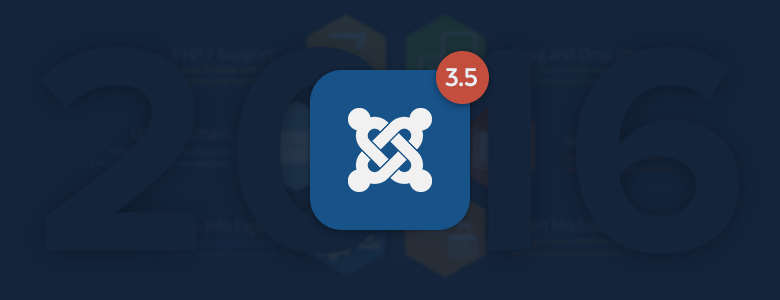
What is the key to its success? That isn’t really an easy thing to tell. Joomla has a growing community of users, testers and developers to maintain and develop it, or simply keep the system alive. It is a stable system, which might seem a little complicated at first, but once you get the hang of it amazing websites can be created using Joomla. In case the Joomla core wouldn’t have a feature you need have a look at Joomla Extension Directory where countless plugins, modules and components are available made by awesome companies and talented individuals.
Let’s take a look at Joomla’s present and future, or in other words, what happened and what will happen to Joomla in 2016.
Joomla 3.5
The currently available version of Joomla, 3.5 was released on 21, March 2016, introducing a variety of changes, from small features (editor buttons were replaced) to large ones (PHP 7 compatibility). The latter under the hood feature doesn’t just seem large, it really is, yet the update went almost surprisingly smoothly. Of course, there are other changes Joomla 3.5 brought into our website’s life that are worth mentioning, so let’s have a look at them!
PHP 7 support
Version 3.5 is the first Joomla version that supports PHP 7. This is good news for people wanting to change to PHP 7 to get its great new features. It is said that this PHP version is the most important change since PHP 5 (which is kind of expected, as the previously released version were PHP 5’s subversions, and PHP 6 was skipped), and that this version comes with great performance increase and better memory consumption than any previously released version.
Supporting PHP 7 caused a bit of backward compatibility break within Joomla, as a class had to be renamed, which might cause issues with older plugins, but in most of the websites it should be fine. Not just Joomla 3.5, but Smart Slider 3 supports PHP 7 so if you weren’t sure if you would be able to use the extension now you know that nothing can stop you to upgrade to PHP 7.
TinyMCE Drag & Drop Images
The content is the spine of the website, and in Joomla, most of the content comes from articles. But articles don’t necessarily contain texts only. In most cases, there are images to illustrate the story, introduce the article, give additional information or simply because a high quality, carefully chosen image looks great anytime and anywhere. Joomla 3.5 wants its users to be able to upload new images while the article is being edited, simply drag’n’dropping the image from their computer to the exact place where the image should be shown.
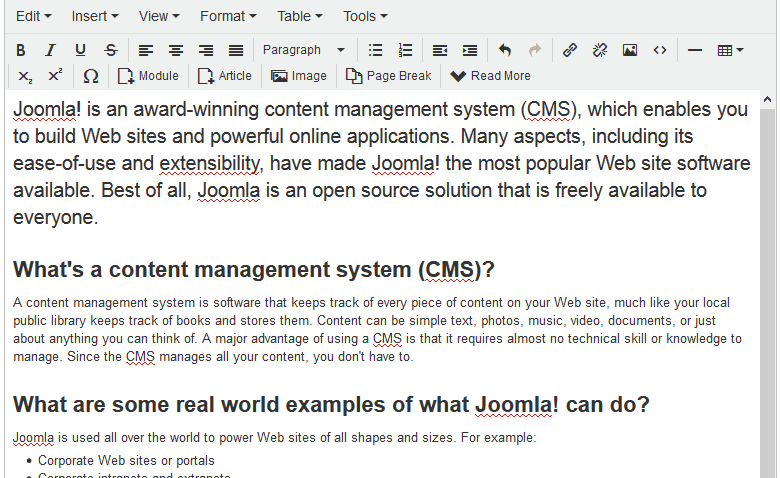
Some notable additions to this feature: when you are trying to upload an image that already exists in the upload folder (by default it is “images”), there will be a message shown that the image already exists and cannot be uploaded. If the existing image is the same as you wanted to be uploaded, it can be selected using the add media method. Otherwise, the image can be renamed and the upload can be tried again.
The author of this plugin promised a more user friendly solution for this problem, where the image to be uploaded is renamed automatically to avoid any conflicts. Sounds great for me!
Insert Modules into Articles
There isn’t anything new on the possibility to add modules into an article, just until now the method wasn’t really user-friendly. (A code had to be inserted using a strict syntax that wasn’t so unequivocal or easy for new Joomla users.) Finally, the era of having to write codes for such a simple option ended: Joomla 3.5 placed a new option to the TinyMCE toolbar called Module. When clicked, it opens a simple, easy to use popup where the users can search for the module they wish to include.
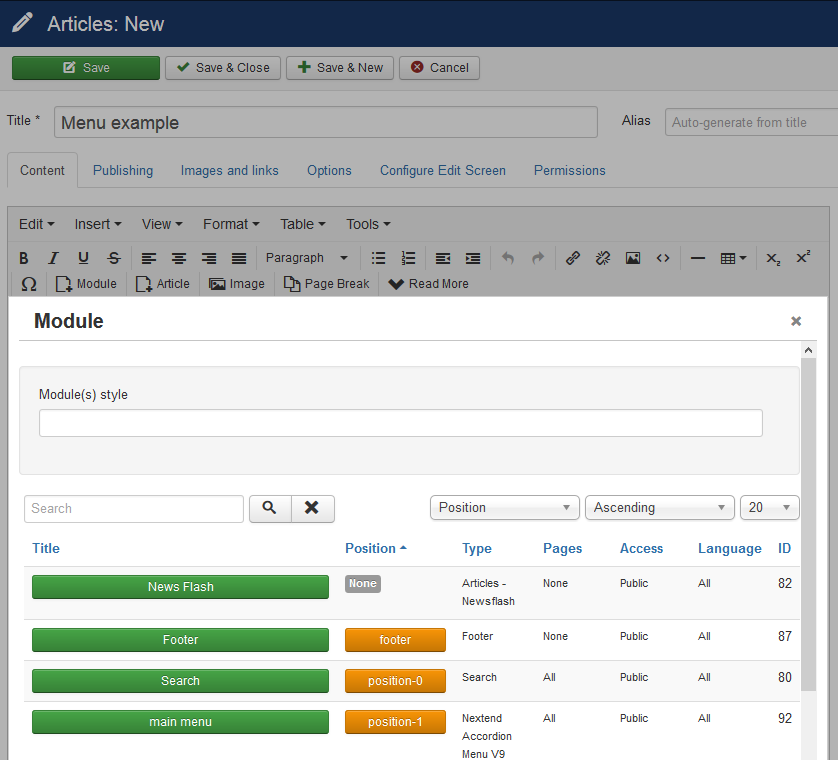
The intuitive new feature allows to insert both specific modules and complete module positions with just a couple of clicks. I do believe this is one of the best and most useful features Joomla 3.5 introduced.
Count items
When you have a Joomla site, you probably have lots of articles in different categories and multiple menu points in each Joomla menu. From now on, Joomla will help its users keep track on the published, unpublished and trashed elements within a category or menu.

Update e-mails plugin
Keeping your website’s core, Joomla up to date is a key element of having a website. The newer versions doesn’t always bring visible and noticeable changes: it’s quite often that there are important “under the hood” features introduced, like security fixes and support of a new PHP version. The thing is that once a website is installed and running, it often happens that the uploaded content is not changing at all for a very long time (e.g. company websites that are offering the same services since the very foundation of the company, without any changes), so the users who would be able to install an updated Joomla version are not logged in and do not see the possibility to do so. From now on, the website’s Super Users will be notified via e-mail when a new Joomla version is released.
Editor buttons on the toolbar
When one is writing a long article in Joomla, they are likely want to add a “Read more” button, which will introduce the article in a few sentences, to raise the user’s’ interest to read the rest of the article. Naturally this feature was available for a very long time, but it was placed to a not so comfortably reached position: below the article editing area, and usually, a bit of scrolling was required to get there.
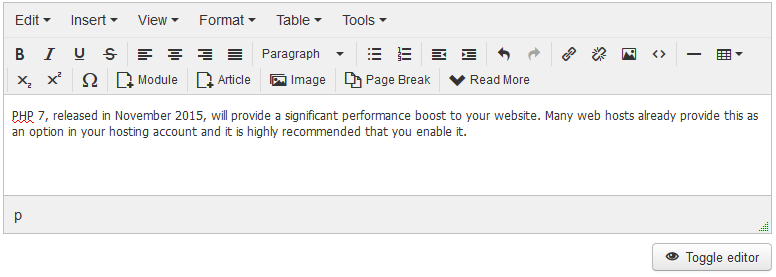
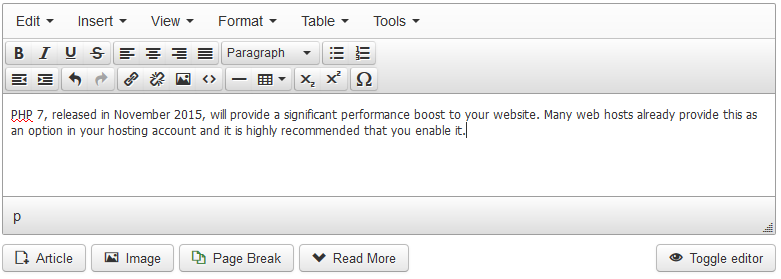
Other new features
There are some other new features worth being mentioned, like the statistics plugin, that gathers anonymous data from one’s Joomla Installation and sends it to the Joomla developer team in order to help them understand their users needs better. The script sends the PHP and the Joomla Version, database engine and version and server OS. No identifying data is recorded, and the collected data can be reached here.
Protostar, one of Joomla’s core frontend template is now capable of automatically loading the user.css file from it’s css folder, where user customizations can be made.
When support is requested, one is often asked to provide system information. From now on, all the necessary system information can be exported and it’s ready to be sent as it does not contain any sensitive information.
Joomla 3.6
Joomla 3.5.2 will be released as Joomla 3.6 Joomla Production Leadership Team revealed that they’re doing a version shifting due to their versioning policy. So they need to make a minor release if they would like to release the improvements of the Joomla Update Component.
The features they had planned to introduce in Joomla 3.6 are shifted to version 3.7. However, most of the articles written on these new features are promising they’ll be available in version 3.6, in real, they won’t be released until Joomla 3.7. So bear the version shifting in mind and don’t let the early written articles confuse you!
The planned released date of Joomla 3.6 is 15th June, 2016.
Joomla 3.7
During the writing of this article, it was revealed that Joomla PLT is already thinking about releasing version 3.7. Knowing that the features promised to arrive in version 3.6 will be shifted, this isn’t that surprising news. So, let’s see some of the delayed features!
There was an expected routing change in Joomla 3.5, but this feature wasn’t tested completely when the Joomla 3.5 beta was released, therefore it will be added to the next minor release. At the Joomla CMS Development community the following new features are mentioned beside the new routing system which are most likely to make it to Joomla 3.7: Media manager improvements, Custom fields.
Let’s be honest, Joomla could use a great media manager (which is capable of resizing the images) since the very beginning, and a lot of users will be satisfied with a new feature like this. Not to mention how useful the custom fields will be when it comes to adding extra information to one’s articles. Who wouldn’t use it?
Our favorite links this week
We curate web design and development related content for you week by week. Useful, interesting and educational links that you might want to visit.
- Tabs vs Spaces
Silicon Valley really hits the nail on the head here 🙂 - And the Most Popular Programming Language is…
Lies, damn lies, and statistics… - Design Disruptors
The future is designed. A documentary by Invision - Google Says Mobile Speed will Soon Impact Rankings
The speed of your mobile pages currently doesn’t impact your mobile rankings, but soon it may.